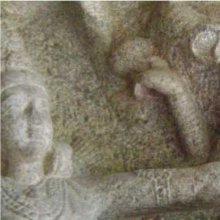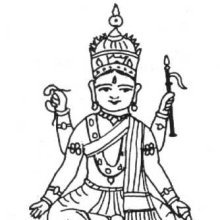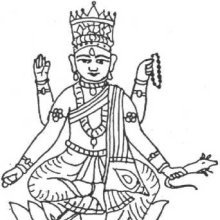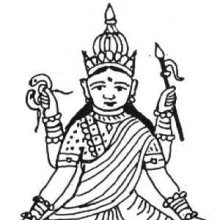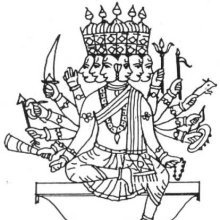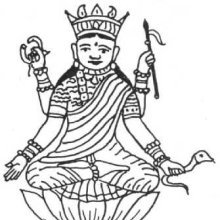Noose: 1 definition
Introduction:
Noose means something in Hinduism, Sanskrit. If you want to know the exact meaning, history, etymology or English translation of this term then check out the descriptions on this page. Add your comment or reference to a book if you want to contribute to this summary article.
Images (photo gallery)
(+58 more images available)
In Hinduism
Shilpashastra (iconography)
Source: Shodhganga: Elements of Art and Architecture in the Trtiyakhanda of the Visnudharmottarapurana (shilpa)The Noose is associated with Varuṇa, whose iconography is described in the Viṣṇudharmottarapurāṇa, an ancient Sanskrit text which (being encyclopedic in nature) deals with a variety of cultural topics such as arts, architecture, music, grammar and astronomy.—The Viṣṇudharmottarapurāṇa accepts four hands in the image of Varuṇa where as the Kāśyapaśilpa and the Śilparatna acknowledge only two. The Viṣṇudharmottarapurāṇa says that the image of Varuṇa holds a lotus and a noose with his right hands as well as a conch and a jewel box with his left hands. Thus it is clear that the Viṣṇudharmottarapurāṇa offers a great field of knowledge regarding the nuances of Indian art of Image making [e.g., the noose] during 10th–11th century A.D.

Shilpashastra (शिल्पशास्त्र, śilpaśāstra) represents the ancient Indian science (shastra) of creative arts (shilpa) such as sculpture, iconography and painting. Closely related to Vastushastra (architecture), they often share the same literature.
See also (Relevant definitions)
Full-text (+740): Pasha, Nagapasha, Kalapasha, Pashabandha, Pashapani, Pulakanga, Varunapasha, Pashin, Galaphamsa, Pashadhara, Bleshka, Veshka, Saraphamsa, Pashya, Shemsara, Varuna, Phasa, Bandhanagranthi, Pashasana, Pashahasta.
Relevant text
Search found 105 books and stories containing Noose; (plurals include: Nooses). You can also click to the full overview containing English textual excerpts. Below are direct links for the most relevant articles:
Trishashti Shalaka Purusha Caritra (by Helen M. Johnson)
Part 2: Spring festival < [Chapter III - Eighth incarnation as Vajrāyudha]
Part 3: War between the Rākṣasas and Vānaras < [Chapter VII - The killing of Rāvaṇa]
Part 5: Killing of Bāṇa < [Chapter VIII - The episode of Sāgaracandra]
The Gautami Mahatmya (by G. P. Bhatt)
Chapter 55 - Holy centres Yamatīrtha etc.
Chapter 101 - Urvaśītīrtha and other Holy Centres
The Garuda Purana (abridged) (by Ernest Wood)
Chapter I - An Account of the Miseries of the Sinful in this World and the Other
Chapter II - An Account of The Way of Yama
Harivamsha Purana (by Manmatha Nath Dutt)
Chapter 46 - The Battle of the Gods < [Book 1 - Harivamsa Parva]
Chapter 85 - War between Krishna and Asuras < [Book 2 - Vishnu Parva]
Chapter 24 - The Fight between Madhu and Vishnu < [Book 3 - Bhavishya Parva]
The Jataka tales [English], Volume 1-6 (by Robert Chalmers)
Jataka 388: Tuṇḍila-jātaka < [Volume 3]
Jataka 209: Kakkara-jātaka < [Book II - Dukanipāta]
Jataka 502: Haṃsa-jātaka < [Volume 4]
The Padma Purana (by N.A. Deshpande)
Chapter 12 - Śiva Arrives on the Battlefield < [Section 6 - Uttara-Khaṇḍa (Concluding Section)]
Chapter 64 - Rāma’s Army Revives < [Section 5 - Pātāla-Khaṇḍa (Section on the Nether World)]
Chapter 111 - The Sinner Vidhṛta Goes to Śiva’s Abode < [Section 5 - Pātāla-Khaṇḍa (Section on the Nether World)]
